| Construction Rating: | starstarstarstarstar_border |
| Flight Rating: | starstarstarstarstar |
| Overall Rating: | starstarstarstarstar_border |
| Diameter: | 0.98 inches |
| Length: | 9.32 inches |
| Manufacturer: | FlisKits  |
| Skill Level: | 4 |
| Style: | Scale |
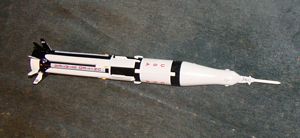
Brief:
If you're looking for a good scale Saturn model but don't have the money and/or room for a 1:100 scale kit (or
larger), then consider this little gem. Standing less than 10" tall and retailing for under $24, this might just
do the trick. It packs an impressive amount of detailing into the model, though in this scale the build can be
extremely challenging. For the faint of heart, there are variations within the kit that result in a less challenging
build at the expense of some scale accuracy.
This review is primarily based upon my experience building a pre-release beta version of the kit, although I have a released version as well and have verified a number of beta-based suggestions for improvement are reflected in the released product.
Construction:
The parts list is a whopping 27 items long, so I'll spare the details and abbreviate. You get a number of tubes,
balsa nose cone/transition, balsa fin stock, assorted centering rings, wood dowel, Kevlar®/elastic
shock cord, plastic parachute, waterslide decals, and pattern sheets. To adhere to scale accuracy, some of the tubes
are custom diameter, which is very impressive for this price.
Oh yeah, you also get two sizes of Plastruct. More on that later...
OK, let's get a few things out in the open right up front. Building a Saturn 1b can be as much or as little effort as you want to put into it. For the more casual/sport modelers, as long as you get the 8 tanks and basic structure in place, it will look fine on the pad. For the more obsessive-compulsive Apollo geeks, you'll of course want to hand craft every intricate detail, some of which you'll need a strong magnifying glass to even see. I consider myself leaning mostly towards the uber-geek end of the spectrum, but I certainly do not disrespect the other end. The instructions are generally written somewhere in the middle with occasional references to how to amp up the effort and detail and other times offering options to tone it down a bit. As such, this can be anywhere from a skill level 2 to a 5+ kit. I'm not even going to touch how many hours I spent on construction, but for my free kit I'll just say that I probably earned single-digit cents per hour (but I got a really low number and Jim's autograph to boot).
Construction begins with the central motor tube and the 8 tanks. The motor tube is basic 13mm with a motor block centering ring. The clusters are BT-2 (6mm) tubes that need to have sections cut from them in order to fit properly around the relatively fat BT-5. Don't even think about clustering this (and I'm the guy that clustered 16 canted MMX motors around a 24mm central on a Soyuz last year). The BT-2s are just too small and going for T-2.5s would blow the whole scale.
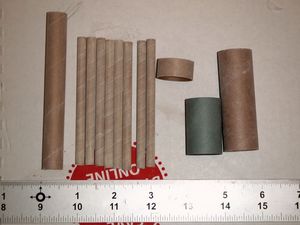
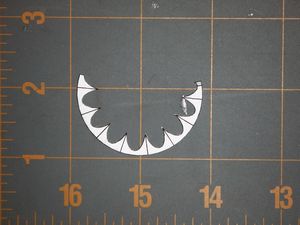
A few tips on trimming the BT-2s: slide a launch rod or dowel inside them before cutting to make straight cuts easier and be extremely careful in sanding the edges afterwards--not just to avoid sanding them too small but also to avoid bowing the cut tubes out. As it is, fitting 8 sliced tubes around the BT-5 leaves very little room for error and will likely require a dry fit first. Also, before gluing the tank tubes in place, consider the paint options--if you choose one of the missions with alternating black and white tanks, then you'll either have some challenging mask work down the road, or need to pre-paint the tanks before gluing them on (as well as pre-painting the shroud/fin can). In my case, I opted to pre-paint the tanks and fin can.
The fin can is a short piece of BT-50 that slides over a single centering ring on the aft end of the tanks. Two rings would ensure better alignment, but there really isn't much room in this scale for another one so you have to visually try to keep it aligned with the tanks.
The fluted shroud is made from pre-printed paper (not cardstock) so it forms very easily. I'm proud to say that this is the first commercial kit I've seen (of about 15) that puts the seam/overlap on the shroud through the centerline of a fin mounting location. Every other kit out there puts the seam at the nadir of one of the cutouts, exposed to all the world to see (or hide through finishing effort). One little beta tip made it into the final product.
The top of the tank/motor tube assembly gets a couple centering rings for the main tank to sit on, and these rings also anchor the shock cord. The main tank (custom BT-48) slides over the rings and tanks.
There are options for fins. Since 1bs are notoriously unstable with scale fins unless helping out with nose weight and/or canted fins, FlisKits includes a plug-in fin can with large fins that can be used for flight. If using just the scale fins, you'll need to add nose weight to achieve the CG specified in the package. Either way, you'll want to build the scale fins at least for display. This is done by cutting out the rough outline using the pattern sheet, tapering the edges by sanding, and then covering them with a scale-like wrap that helps run the extended tip cord up the fluted shroud. Not quite as complex as the Estes/Centuri/Semroc built-up fins, but it can be tricky.
If foregoing the plug-in oversize fins, you'll need to fill the pre-drilled nose cone with lead shot. Lead. Not BB's and not clay. There's not much room, and you need to add a lot of weight. To avoid dealing with regulatory hassles related to shipping a "toy rocket" with lead, FlisKits does not provide any lead shot, clearly warning the modeler to acquire this on their own. Jim was kind enough to send me a baggy during the build, but I had to promise not to sue him as well as to not eat the leftovers.
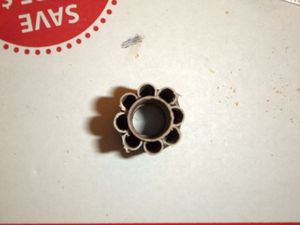
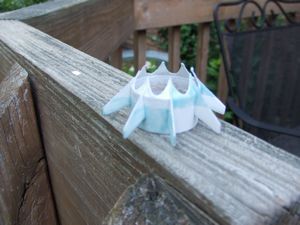
Now comes the most important decision you'll make on the project: the tower. Most Saturn kits out there allow the modeler some flexibility to build in accordance with personal thresholds of pain. Zooch kits, for example, typically include a preprinted fold-up tower and dowels/wire for making a built-up tower. Semroc puts you through the dowel sanding/cutting/gluing pain just like the original Estes kit, and many modelers simply buy a plastic capsule kit from Apogee and avoid the hassle. For the Flis 1b, you can:
- Wimp out and use a printed fold-up tower,
- Show you're a true rocketeer and build one up using 0.020 and 0.010 Plastruct, or
- Show you're really obsessive/compulsive by soldering up a tower using your own wire (roughly 32 and 40 gauge).
Since I'd only just taught myself to solder and certainly did not feel up to the task of micro soldering, I went the Plastruct route. It was a very humbling experience, and after finally getting a tower done I didn't hate too much (threw out several failed attempts), I told Jim not to expect me to build one for NARAM as it would be at least 6 months before I'd feel like even trying another tower.
Actually, the Plastruct approach is not all that bad, but you really need good eyes, tools, and a steady hand. For starters, buy a good pair of tweezers. If you're like me and most modelers, you didn't actually buy a pair but have borrowed/stolen the wife's pair a long time ago. Those are not what you want here with their big fat, flat tips. We're not plucking eyebrows, we're assembling a tower from micro-sized rods. You need tweezers with needle/pointed ends. I found a great pair with an attached magnifying glass at Radio Shack (product 63-1310) and cost me a whopping $2 plus tax. That is the best $2 I've ever spent, but I didn't find them until after I'd built the tower. You'll also want to think through the glue and how to apply it. Jim used super thin CA. I used liquid plastic cement, brushed on with a single-hair brush. I found my application to be too heavy and occasionally melted the rods. About a month after building it, I saw a lecture by an artist that sculpts on the head of a pin, and he was describing how he paints at that scale. He found a dead fly in his apartment, plucked one hair from the fly's head, and uses that as a brush. I'm thinking about calling this guy (or looking for a fly)...
The tower construction is much like other built-up kits: build one side, flip it 90 degrees, and add another side to it. Repeat for another pair of struts, then mate the two sub-assemblies together. It's just a little but more difficult when dealing with a something that finished is only about half an inch tall.
With the tower done, you get to make a set of 4 nozzles by sanding the dowel to a tapered point 1/4" long then cutting 3/32" off the tip as a nozzle. I lost my first one when it went whizzing off the table onto the carpet, where it blended right in to the dust, crumbs, dog dander, etc. Hint: lay the dowel tip on a piece of tape when cutting off the nozzle.
The rest of the construction all comes down to how much effort you want to put into the model. There is a pattern sheet with a large number of details and notes on where to place them. Some of these are made by simply cutting out the cardstock pattern itself, others by using material you have to scrounge up on your own. You can, for example, simply use the waterslide decals for the RCS nozzles or you can build them into 3D detail yourself by cutting 4 tiny patterns out and gluing them on top of each other. Note that there are 6 sets of patterns provided, allowing 2 throwaways. In my case that wasn't enough so I reprinted a bunch of spares from a PDF of the sheet Jim sent me. I will say that in terms of the degree of scale accuracy reflected in the details, if you build everything on the pattern sheets you will wind up with a kit rivaling the Apogee in level of detail, greatly exceeding such fine kits as the Semroc/Estes and the Saturn Press Saturn V. You just may go blind getting there. The only quibble I have with the excellent details is that there is no suggestion for material thicknesses or types to use. Knowing something should come from 0.030 Plastruct versus 1/32 balsa might be helpful and avoid rework or sloppiness, although admittedly, most modelers would not have many materials laying around other than basic balsa/basswood/plywood.
Finishing:
Finishing a Saturn 1b tends to be almost as difficult as building them, and there's nothing different about this kit.
The fin can gets a complex masked pattern of alternating black and white sections. The tanks generally alternate white
and black, depending on the mission to model (same with fin can, for that matter). S-IV B stage (upper tube) gets a
black/white roll pattern and black upper ring/stripe. Tower/shroud all white. Shooting everything with a base white
generally works, and the masking takes a long time but is worth it. At least in this scale you don't have the fun of
masking over corrugations...
There is a very detailed 4-view drawing showing the paint patterns, dimensions, etc., and this is also used for most decal placement.
One note on the decals: I know Jim had a lot of fun with this. When I took a glance at the PDF file pre-production, they looked generally right although I didn't compare them to my detailed scale prints. I couldn't tell though in looking at the file whether any of the white was printed white or simply clear over a white background. I kiddingly sent Jim a reminder that the tanks, as an example, need a white printed background for the decals going over the black tanks or the modeler would have to mask a really tiny strip that would look like fecal matter. He made sure to print those United States decals with a white undercoat but didn't catch this on the mission labels (ex. SA-205) that go on the bottom of the black tanks. That will eventually be corrected, but I suspect the first hundred or so kits will have this error. The decal sheet also incorrectly lists the scale as 1:284 and includes a few bogus/incorrect Y/Z axis labels, identified as extra/errors.

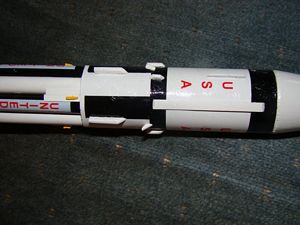
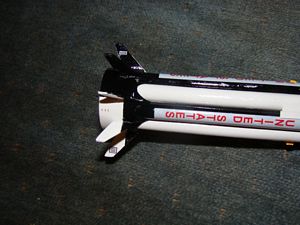
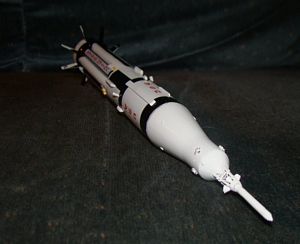
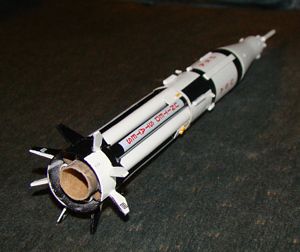
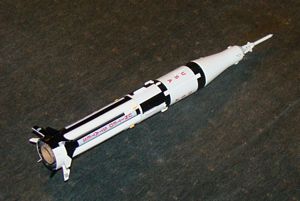
Construction Rating: 4 out of 5
Flight:
I had intended to build this and give it back to Jim as a display model, not to fly, but when he mentioned he was
taking it to NARAM, I suggested he fly it for the Saturn celebration and/or vendor showcase. I didn't deface it with a
launch lug, and when Jim threatened to drill a small hole for a pop lug, I offered up a 13mm piston instead and helped
him prep it since he hadn't caught on to this "new fangled" technology yet.
Only one small problem though: Jim had flown his boilerplate just fine on A3s and A10s but didn't realize the piston would add at least 20% to the boost so when it took off on an A3-4T, it really cooked and almost flew out of sight. The flight was perfectly straight and stable, especially impressive in the winds that were steady at 12+ and gusting close to 20 mph.
Recovery:
The standard Flis chute included is one of those plastic ones that's 16" with patterns for cutting down as small
as 6" or so. Jim went with the smallest configuration, which would normally be fine for this model, but on the
small NARAM-51 field and high winds, proved to be fatal. The model quickly blew out of sight, drifting well over 100
yards, down below the horizon, and probably wound up somewhere in the neighboring cow/horse fields. It was short grass
and there would be plenty of traffic through those fields over the ensuing week, so I figured it would turn up but no
luck. I walked the rough line several times and came across a couple other models including one other Flis demo, but
the 1b never showed up. It was a wonderful model that simply vanished in the winds on its first flight.
Flight Rating: 5 out of 5
Summary:
Despite the disappointment of losing such a nice model and so much work, I have to say I was very impressed with this
kit and highly recommend it with a few caveats. This is by far the most complex build of the Flis line, and although it
can be built with some time-saving techniques, you should really go into this expecting a significant effort for which
you'll be greatly rewarded with an outstanding model. It may be small but packing the same (or more) detail of the
bigger guys into this tiny scale winds up making this much more difficult, not easier. If you're up to the challenge,
jump right on this. If not, you might want to start with the Zooch line, which are more like a weekend afternoon build,
working your way up to this later.
Overall Rating: 4 out of 5
 |
 |
Flights
Sponsored Ads
 |
 |











